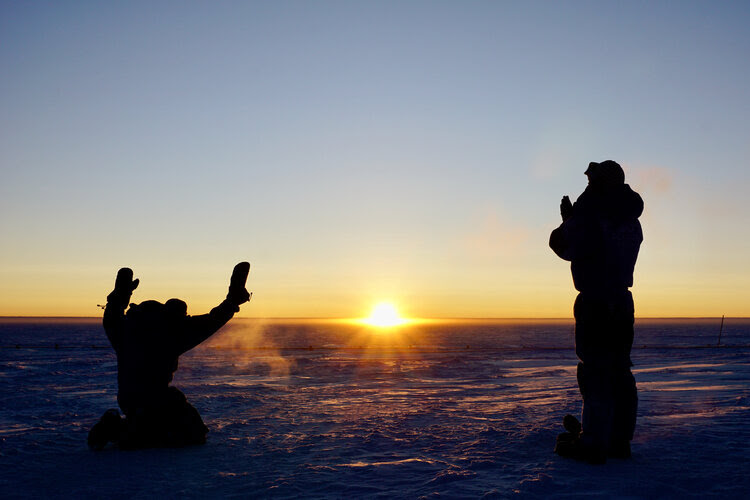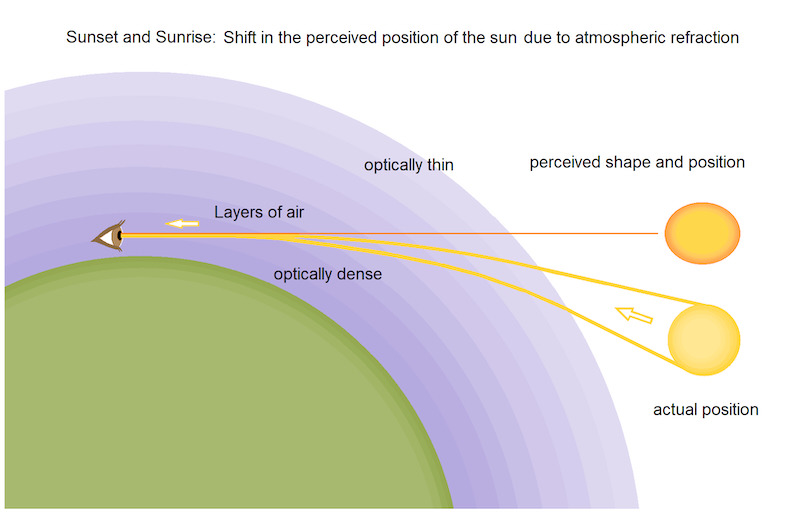The video above is from the South Pole during polar sunset in March 2022, when the sun goes from having been up for 6 months to being down for the next 6 months. So, during the equinox, the sun scrapes along the horizon during the entire day. But did you know that the equinox sun looks exactly the same at both poles at the same time? Video via South Pole Telescope.
An EarthSky reader sent us a question a while back – at the September equinox 2023 to be exact – to ask how an equinox looks at the North and South Poles. Would it, due to refraction, be above the horizon at both poles at the same time, and all day long? This turned into a delightful exchange of emails (we do love chatting with our readers!) where we mused on the topic of polar equinox. Our reader, Rod Cavanaugh, had it all figured out! He wanted to make sure his ideas were correct … and so they were.
Equinox sun at the North Pole
At the poles, the year can be divided into one night and one day, or rather, half a year of darkness and half a year of daylight. The transition between these two states of sun-presence on the sky occurs during the equinoxes. At the North Pole, the sun has now been below the horizon for the entire winter. During the March equinox, it pops above the horizon – polar sunrise – to then sit in the sky for the entire summer, higher and higher each day until we hit the summer solstice. So, during equinox day, it follows the horizon all day long.
Polar sunrise for South Pole in September, sunset in March
At the South Pole, it is the opposite: the sun has been above the horizon for half a year, and now, during the March equinox, the day transitions via polar sunset, into eternal (or, rather, half a year of) darkness.
So, half the sun is below the horizon and half is above it, at both poles. Or at least that is how it would look like without the Earth’s atmosphere.

The sun is above the horizon at both poles at the same time
But, here comes the surprise! Due to refraction, a sun on the horizon does not appear to be half below it and half above it, even though it geometrically would be. The atmosphere refracts the light that hits your eye, such that the sun appears to be about 1/2 a degree above the horizon at both places. Our reader, Rod Cavanaugh, wrote:
If the atmosphere’s refraction raises the sun about 1/2 a degree and the sun’s angular diameter is about 1/2 a degree, then at sunset the actual/geometric sun should be completely set at the time the apparent/refracted sun first touches the horizon.
But from the poles, the center of the sun should be exactly on the horizon at the equinox, so there should be a gap of 1/4 a degree between the apparent sun and the horizon, meaning the sun is completely above the horizon at both poles on the equinox.

Not only on the horizon, but above it
Rod asked if this seemingly counterintuitive situation is correct. And indeed, it is! A sun that sits 1/2 a degree (30 arcminutes) below the horizon is refracted 33 arcminutes. But the equinox sun is a bit higher (not below the horizon yet, but half above and half below). This means that there will be a gap between horizon and sun. The gap won’t be exactly 0.25 degrees, but the top will be refracted between 25 and 29 (we can assume 27) arcminutes, and the bottom part (0.25 degrees below horizon), about 31 arcminutes. So, Rod’s thought experiment is correct. There will be a gap of about a quarter of a degree (about 15 arcminutes), so the sun will appear a bit above the horizon at both locations. Also, the sun will appear oval because the upper limb (edge) is refracted less than the lower.
Bottom line: We know the equinox sun rises due east and sets due west. But what happens at Earth’s poles? Turns out the North Pole sun is above the horizon all day long. And it looks exactly the same at the South Pole!
Atmospheric refraction explained
Watch the sunset at the South Pole on NOAA/ESRL’s South Pole Live Camera











